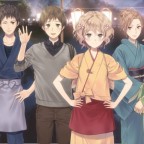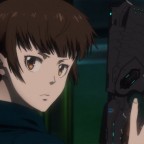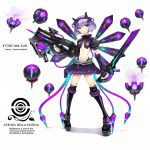Welcome to the NHK DVD Review
Have you been looking for a light-hearted yet adult oriented anime series? Do you believe anime can have inherent values and address real life issues head- on? If you answered yes to any of those questions than you should probably watch Welcome to the NHK.
Sato Tatsuhiro grew up as a normal teenager. But an incident on his first day of university life has left him mentally tainted, forcing him to become a hikikomori (a social shut-in). Fast forward two and a half years into the future, Sato is a drop-out living alone and afraid of confronting the outside world. In comes Misaki, a mysterious girl who decides to take Sato’s wreck-of-a-life as her project. Sato also discovers that his younger high school friend Yamazaki lives nearby, and by pure luck manages to reunite with his former senior Kashiwa. Strengthening his bonds with the two seems like a good way to start rebuilding Sato’s social life. But as Sato soon discovers, both Yamazaki and Kashiwa are struggling with serious issues in their own lives. Can Sato recollect his life and help lift his friends’ spirit in the process? And what are the real intentions behind Misaki’s good will? Sato’s desperate journey for self-recovery begins.
wreck-of-a-life as her project. Sato also discovers that his younger high school friend Yamazaki lives nearby, and by pure luck manages to reunite with his former senior Kashiwa. Strengthening his bonds with the two seems like a good way to start rebuilding Sato’s social life. But as Sato soon discovers, both Yamazaki and Kashiwa are struggling with serious issues in their own lives. Can Sato recollect his life and help lift his friends’ spirit in the process? And what are the real intentions behind Misaki’s good will? Sato’s desperate journey for self-recovery begins.
Only a handful of anime series choose to confront the demons of real life. Even less try to face this reality head-on without resorting to some fantastic element or the other. Welcome to the NHK will show you the unsheltered struggle of a real individual, albeit in a comedic and a bit eccentric manner. Sato can be quite imaginative at times and tends to take everything to the extreme. Because of that he is often dragged into awkward situations, which can be hilarious at times and heartbreaking at others. The series’ emotional pendulum moves back and forth between funny and sad. Just when you think things are starting to look up Welcome to the NHK throws a curve ball at you, forcing you to understand that there are no magic cures for problems of the mind and heart. In this manner the series remains highly entertaining and sobering at the same time.
Welcome to the NHK is targeted strictly at adults. Not because it contains nudity and sexual innuendos (although it does) or because it is too complex for young people to understand. Welcome to the NHK is a series about that fragile period people enter in their 20s. It is a period in which people are already considered qualified adults, yet most still don’t have the balanced life they expect to achieve as ones. By faithfully recreating this fragile period Welcome to the NHK forces you to question your own prowess. Sato, Yamazaki, Kashiwa and most of the other characters are young adults struggling to find their place in the world. Each of them faces a certain problem that hinders his or her ability to live a healthy positive life: Sato is too prone to outside judgment, Yamazaki doesn’t trust other people to a fault, Kashiwa is afraid that even the smallest of changes will bring misfortune to her successful life, and so on. The story is shown almost exclusively from Sato’s point of view. Being a shut-in Sato is not a very active person and it takes time until he opens up to the other characters this series has to offer. Luckily Sato is an interesting character and can support the series for the couple of episodes it takes to really lure us in.
I say a couple of episodes since the first four episodes in Welcome to the NHK are quite unimpressive compared to what the series eventually offers. These episodes are oversimplistic, contain too much obscene material and don’t make much progress. The forth episode, in which Sato and Yamazaki visit Akihabara, is by far the worst episode in the series. This episode suffers from very poor drawings and obvious budget-related shortcuts. It’s also one of the episodes in which character designs are not consistent, further diluting the experience. Strange enough those first few episodes contain hints to events that occur later in the series. While it doesn’t change the fact that they are inferior to the rest of the episodes it does put them in a little better light.
If you do manage to cruise by these initial episodes though you’re in for a treat. The cast of Welcome to the NHK really grows on you as time goes by, and their personalities evolve and adapt to their new surroundings. It’s a genuinely interesting watching experience, both from a casual point of view and an intellectual one.
While he himself will go to great lengths to prove otherwise, Sato is a surprisingly intelligent and caring person. It is because of these good traits that despite his own demons Sato finds in him the strength to interact with his friends and try to support them. Sato is in turn supported by Misaki – an enigmatic teenage girl who seems to want to help him cure his hikikomori predicament. But it is clear from the start that Misaki is no angel – she doesn’t reveal any personal information about herself, knows too much about Sato despite only meeting him recently, and forces him to sign strange contracts to rectify their makeshift relationship. In the first part of the series Misaki is kept in the background while the other characters are introduced. Only in the second part of the series does she take front stage and becomes a more proactive, and therefor important, character in the series. Overall she might seem like a sidetrack at some points but manages to become a key character when it really counts.
The ending themes of Welcome to the NHK really stand out. The first half of the series features a twisted sordid song called dancing human baby, while the second half offers the bittersweet modokashii sekai no ue de. Both manage to tap the full potential of the series and greatly enhance its atmosphere.
For this review I watched the FUNimation Entertainment S.A.V.E. edition of Welcome to the NHK. Just like all the other S.A.V.E. titles out there the spine of the Welcome to the NHK DVD case has an ugly green color to it, with the word S.A.V.E. displayed in big letters and the title of the actual series written in tiny letters which cannot be read from afar. Similarly, like all other S.A.V.E. titles, this DVD has a reversible cover to fix this issue. As a single DVD case the green overlay isn’t that much of a problem, but if you already have more than one or two S.A.V.E. titles up your arsenal than switching to the reversible cover is a must. You don’t want a block of indistinct green DVDs on your shelve. Inside, the case contains four DVDs on a rotating hinge. I actually liked this design because it doesn’t stack the DVDs on top of each other and minimizes scratch potential. The DVD menu is simplistic and easy to navigate. It immediately shows you a list of all the episodes on the DVD to choose from. There is no scene selection screen. Although there is an extras menu the only extras for this release are clean opening and ending themes. The rest of the extras consist of a plethora of trailers. My only real gripe about this is that the second ending theme (modokashii sekai no ue de) didn’t get the clean treatment for some reason.
The show itself uses exactly the same audio, video and subtitles as its initial ADV release. You can watch the series in English or in Japanese with English subtitles. And even though this choice is not presented at the DVD menu you can also use your DVD remote to turn off the subtitles entirely when watching the Japanese dub. Likewise, you can watch the English dub with English subtitles. But you wouldn’t want to watch this series in English. While Yamazaki’s voice is spot-on, Sato’s voice is way too feminine and meek. Misaki is even worse, featuring a voice of a thirty year old woman trapped in a young girl’s body. Luckily the subtitles are superb. The translator really gave it his all, translating not only the conversations but also the many signs and contracts that appear in the episodes. These translated signs and contracts overlay the actual visual content, replacing the Japanese text so that they don’t interfere with the spoken text bellow.
When visual fidelity is concerned Welcome to the NHK is showing its age. This series wasn’t a visual spectacle in 2006 and suffers greatly from the scaling of today’s HDTVs. The series is heavily plagued by pixilation, which for the most part appears in the background but in later episodes also appear on people’s faces. It’s a detracting factor, but taking into account the series’ age and the subjects it portrays it is definitely not a deal breaker. Sadly Welcome to the NHK also suffers from inconsistencies in character designs, which have nothing to do with SD or HD visuals at all. This is most apparent in episodes 4 and 19, in which Sato barely resembles the way he looks in all the other episodes. Gonzo should have fixed those inconsistencies for the DVD release as they lower the high standard the rest of the series so rigorously upholds. There is another serious (albeit easily fixable) problem in this set: the back of the FUNimation DVD claims that the picture ratio is 16:9 when it is in fact 14:9. So be aware that watching this series in 16:9 ratio will crop the upper and lower parts of the video shown.
Welcome to the NHK has some minor issues and hasn’t aged that well. Despite these issues it stands as an incredibly rich and well-packed experience. It courageously ventures where few series dare to go and manages to be an immensely satisfying ride. If you want to be entertained, intellectually stimulated and emotionally moved you own it to yourself to check out Welcome to the NHK.
Pros:
– Deals with adult themes without derailing to imaginative lines.
– Can be funny, sad and touching all at the same time.
– Likable unique characters which are never stereotypical.
Cons:
– Character designs are inconsistent in some episodes.
Final Score: 9.5/10
Product Information: Welcome to the NHK Complete Series S.A.V.E. Edition. Published by FUNimation Entertainment. Release Date: October 12, 2010.
Review Equipment: Sharp 40-Inch LCD LED HDTV (LC-40LE810E) connected to a Premier DVX131 DVD using an HDMI cable.
Related Reviews:
Related Products:
























